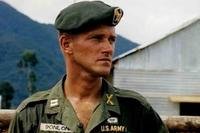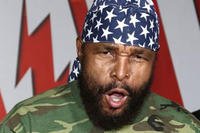Moviegoers have seen it all by now. We've seen tornadoes full of sharks, trucks fighting jets and Nic Cage swap faces with John Travolta after landing a helicopter on an airplane. Such outlandish mayhem gets a little ridiculous after a while, but the real world is full of its own unbelievable stories. Audie Murphy's one-man fight against the Nazis in Europe might seem like something straight out of a modern action movie, but his movie was actually made a decade after the battle ended -- and it still stands up today.
In January 1945, Allied victory in Europe was anything but assured. The German military launched a major offensive in December 1944 that had pushed Allied lines back into Belgium and France, but the resulting Battle of the Bulge forced the Nazis into a retreat. They were far from finished, however: on New Year's Eve, Nazi Germany launched what would be its last major offensive on the Western Front. Operation Northwind was an attempt to bolster its forces in the Bulge and destroy two Allied armies.
American and French forces would fight for more than a month to not only prevent a German advance, but to push the Nazi Wehrmacht back into Germany. Though they finally succeeded, a powerful force of some 30,000 or more Germans were centered around the city of Colmar, forming a pocket of resistance in Eastern France that American troops would have to retake. Not only was it the last major Nazi foothold on French soil, but control of Colmar also allowed freedom of movement into Germany itself.

One day late that January, near the village of Holtzwihr, northeast of Colmar, German forces struck out at advancing American infantry. This is where Lt. Murphy would single-handedly hold the strategically important forest outside the town, despite being outmanned and outgunned by a veteran German Army.
It's safe to say Murphy knew his way around a battlefield and had a pretty reliable intuition when it came to taking risks. By the time the U.S. Army advanced on the Colmar Pocket, Audie Leon Murphy had already received the Distinguished Service Cross, two Silver Stars and two Bronze Stars. He had enlisted at the tender age of 16, joining the Army in 1942 because it was the only branch that would accept his underweight frame. He was first sent to North Africa, then landed at Sicily, mainland Italy and eventually southern France. He then fought his way across Europe, earning a battlefield commission in October 1944.
Audie Murphy stars as himself, recreating how he received the Distinguished Service Cross as part of the first assault wave landing in Southern France near Ramatuelle, in August 1944.
The danger the Colmar Pocket posed to the Allied advance into Germany was real. If the Nazis broke out, they could have routed the overstretched Seventh Army and then hit the advancing Third Army in the rear, potentially destroying it, too. From there, the Wehrmacht could have retaken the port of Antwerp and pushed the Allies back into the English Channel. That was the reason the Allies couldn't just hole up such a powerful pocket of enemy troops and armor. Something had to be done.
On Jan. 23, 1945, the U.S. 3rd Infantry Division's 30th Infantry Regiment advanced through the Bois de Riedwihr, a forest near Holtzwihr, when it was suddenly attacked by a large force of enemy tanks, tank destroyers and infantry. The 30th was caught in an open ground and was unable to dig into the frozen earth, ending up mangled by the attacking Germans and ordered to withdraw. To fill the gap, the Americans ordered the 15th Infantry to take its place.
The very next day, on the southern edge of the woods, German tanks and infantry hit the regiment's Company B hard, wounding 102 of its 120 enlisted men and killing all of its officers except one: Lt. Audie Murphy.
That same day, Murphy led what was left of his company into the woods, where they, too, were unable to dig any kind of foxhole. They worked through the night but couldn't make any progress in the snow and cold. The next morning, Murphy was reinforced with two tank destroyers from the 601st Tank Destroyer Battalion and used them, along with five armored vehicles, to form a defensive position. It was better but it was still weak, and they could see the heavily defended village of Holtzwihr from this spot.
It was now Jan. 26, 1945. Murphy had made the most of what was available, but was informed that his reinforcements had not yet arrived -- and they wouldn't make it that day. At 2 p.m. that day, six tanks and 250 elite German mountain troops moved out of the village toward their position. Murphy only had time to get to a phone and call for artillery before the shooting started. It turns out the road to a German victory in the Colmar Pocket ran right through the road his company was holding.
The American tank destroyers opened up on the oncoming German tanks immediately, but their fire was ineffective. They were taken out either by enemy tank rounds or poor maneuvering, which scattered surviving anti-tank troops into the forest. The only silver lining was the M10 tank destroyers' mounted guns, which tore into the German infantry, but even that didn't last long. Company B's machine gun crew was hit next. Murphy knew his unit couldn't hold this vital stretch and ordered his men to fall back into the forest. He would cover their retreat while directing artillery fire.
With the Germans advancing and his carbine out of ammunition, Murphy spied a burning tank destroyer and its remaining .50-caliber gun. Instead of going back into the forest, he climbed aboard the turret and began pouring fire into the oncoming enemy advance. He believed the tanks could not advance without infantry, so he began mowing them down. Murphy was right; as he cut down enemy troops, the German tanks were forced to fall back to their own treeline. He fought on as enemy tank shells and artillery exploded around him.

For an hour, Murphy was obscured by smoke and firing the machine gun, stopping only to reload, call in artillery fire or recover from the exploding 88-millimeter shells. After what must have seemed like days, the clouds parted and he was able to get close-air support from Allied air power. In the face of all that firepower, the Germans finally began a retreat toward the village. It was great timing for Murphy, because his phone to Allied artillery suddenly went dead. He left the tank destroyer and rejoined his men in the relative safety of the forest. After he reached the treeline, the turret on which he stood for that entire hour blew up, tossing it sky high.
Refusing to be evacuated or deterred, Murphy then began to plan a counterattack, retaking their original position from the remaining Germans. Company B held its ground throughout that night and the reinforced 30th Infantry Regiment captured the village the next day. Had Murphy not made his stand atop the burning armored vehicle, it's likely the entire company, undermanned and demoralized, would have been annihilated.
Murphy was promoted to first lieutenant and received the Legion of Merit for his leadership during the Colmar Pocket operation. On June 2, 1945, Lt. Gen. Alexander Patch, commander of the Seventh Army, presented the 19-year-old Murphy with the Medal of Honor for his actions outside of Holtzwihr. By the war's end, he would famously receive every medal for valor the United States offered, along with three Purple Hearts for his trouble.

After the war, Murphy went off to Hollywood, where he began a slow but lucrative film career, landing his first leading role in 1949's "Bad Boy." That film led to a contract with Universal Pictures, where he was particularly known for his war movies (whether they were his story or not) and for his westerns. He later parlayed his success in western film into making country music and western television series.
As the most decorated soldier of World War II, he not only wrote his popular autobiography "To Hell and Back," but also played himself in the 1955 movie of the same name, along with some 40 other films, including "The Unforgiven," "The Quiet American" and "A Time for Dying." His performance in "To Hell and Back" was so solid that the movie made him a massive star, one of Universal's "Big Four" leading men alongside Tony Curtis, Rock Hudson and Jeff Chandler.
Murphy would go on to join the Texas National Guard and Army Reserve while being an outspoken advocate of post-traumatic stress disorder research and treatment, from which he personally suffered for the rest of his life. He died at age 45 in 1971, a passenger on a private plane that crashed into a mountain near Roanoke, Virginia, and was interred at Arlington National Cemetery.
Want to Learn More About Military Life?
Whether you're thinking of joining the military, looking for post-military careers or keeping up with military life and benefits, Military.com has you covered. Subscribe to Military.com to have military news, updates and resources delivered directly to your inbox.




























